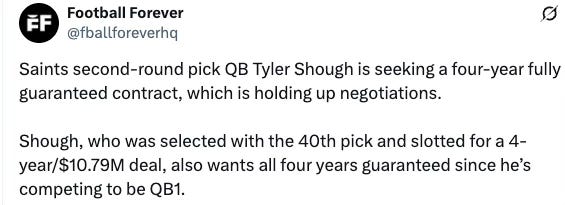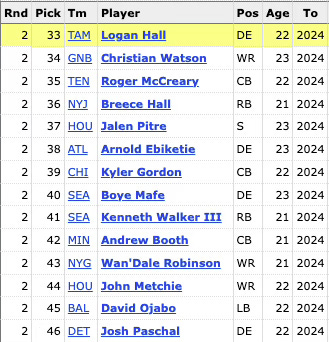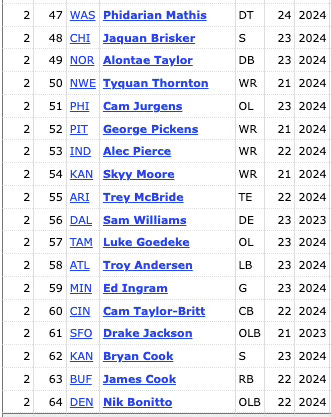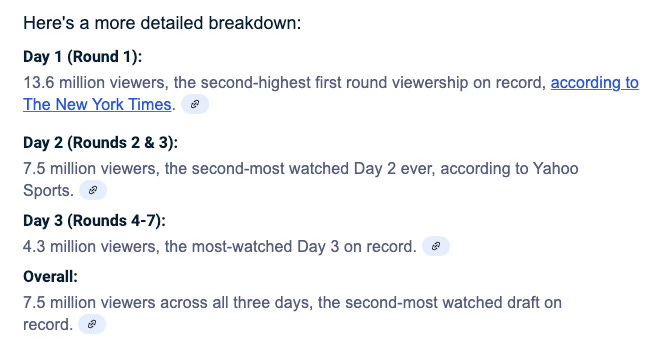A crazy idea to make the NFL better
Stop counting day 2 and day 3 draft picks against the salary cap
The NFL is having a hard time getting second round picks to sign their rookie contracts: Of the 36 unsigned rookies, 30 are second rounders. That’s all but two second round picks who went through OTAs without a contract. Is this usual? At this time last year, all 32 second round picks had signed their contracts.
Here’s my uneducated idea to help both sides — the league and the players — get what they want while simultaneously generating more interest in the draft and potential trades: Stop counting day 2 and day 3 draft pick rookie contracts against the salary cap.
It’s so uneducated and misinformed that it just might work.
Why are so many 2nd rounders unsigned?
This is even more relevant to the Seattle Seahawks since they have two unsigned second round picks in Nick Emmanwori and Elijah Arroyo.
Emmanwori is the highest-drafted second round pick who is unsigned as 33rd overall pick Carson Schwesinger and 34th overall pick Jayden Higgins are the only two to have signed their deals. They’re also part of the reason for the holdup:
Higgins became the first second round pick in history to get a fully-guaranteed four-year contract, so the Browns followed suit in giving the same agreement to Schwesinger. This has also led to quarterback Tyler Shough demanding a fully-guaranteed deal because of his own unusual situation, which is that he’s expected to be the Saints starter despite only being the 40th overall pick:
The Seahawks are under as much pressure to fully-guarantee Emmanwori’s deal as New Orleans is to do the same for Shough because his contract is the domino in-between Higgins and the rest of the second round. If Seattle guarantees Emmanwori’s fourth year (the expected amount guaranteed might have been around 60% of his fourth year) then they’re setting a precedent for the next team to give a fully-guaranteed deal, which would be the Browns and running back Quinshon Judkins.
I can understand the argument for both sides:
Players realize that most second rounders become less valuable as they get closer to free agency
Teams realize that even if they’re squabbling over thousands of dollars in a league that could have a $300 million salary cap by 2028, they’re usually knocking against the ceiling of it every year
The problem for players is that every dollar counts. The amount they earn in the NFL could be what they live off of for the rest of their lives. Schwesinger’s now fully-guaranteed salary in 2028 is $2,449,146. If he had accepted the contract that last year’s 33rd overall pick got, his 2028 guarantee would have been $500,000 less than that.
That’s $500,000!
I don’t care how much money an NFL player will make if he strikes it rich, everybody likes $500,000.
Emmanwori’s expected contract value is $11.6 million over four years, a number that was set in stone before he was drafted. That number can’t be changed because of the rookie wage scale. However, his and Arroyo’s guarantees can be changed, so now every second round pick is looking at the only two signed players in the round (both fully-guaranteed) and saying to themselves that it is time to band together for the greater good.
So what’s the holdup for teams when we’re talking about guaranteeing less than $500,000 of a contract worth 20 times that amount? It seems silly for NFL teams that have annual budgets in the hundreds of millions of dollars.
Well, I can see their argument for not caving to these demands too.
How many 2nd round picks will be good in 4 years?
Go back to the 2022 draft, players entering their fourth season including two current Seahawks (Boye Mafe, Kenneth Walker III), and ask how many of them you believe are worth having guaranteed contracts right now.
These players have a career AV under 10 (which is bad):
DE Arnold Ebiketie
CB Andrew Booth
WR John Metchie
LB David Ojabo
DE Josh Paschal
DT Phidarian Mathis
WR Tyquan Thornton
WR Skyy Moore
DE Sam Williams
LB Troy Andersen
OLB Drake Jackson
Several of these players have already been released, such as Booth and Thornton. Jackson hasn’t played in the NFL in two years. And these players represent over one-third of the second round!
You may recognize that a player like Ojabo came into the NFL with a devastating injury and that’s partly why he hasn’t contributed much yet. Which goes back to the original point: You may want to draft a player like Ojabo in the second round despite his injury, but would you want to do it if you had to guarantee all four years of his deal?
A fully-guaranteed contract will make teams shy away from players who fall out of the first round due to injury concerns. But they could still turn out to be perfectly good players… Look at Frank Gore.
Now let’s look at the opposite end of the 2022 second round: How many of those players look like superstars who are bargains?
Honestly, there aren’t many and in fact the last two picks of the round have been the two of the best: RB James Cook and OLB Nik Bonitto. There’s also tight end Trey McBride, who was already extended by the Cardinals.
The first 30 picks of the round is a mixed bag, even at the top, with players like Mafe, Walker, George Pickens, Breece Hall, Christian Watson, and Jaquan Brisker among those who have to continue to prove themselves going into their fourth years. Teams are afraid of fully-guaranteeing deals for 2025 second round picks when they know that half of these players could end up competing for their jobs in 2028.
I can’t imagine that it is the CASH that’s making teams hesitate to sign these second round picks. It’s not enough cash to assume that the Seahawks would hesitate to guarantee the fourth year of Emmanwori and Arroyo’s contracts.
Instead, it seems like it could only be the salary cap considerations.
Well, what if we just got rid of those?
Potential Benefits of Not Counting Day 2/3 Rookies Against Salary Cap
Day 2 / Day 3 picks just got a lot more valuable
All of a sudden, trading the 10th overall pick for two second round picks might make a lot of sense. Now a team isn’t just getting two players instead of one, they’re getting two “free” players instead of one player who costs $7 million per season.
That’s also why I did not include first round picks in this “no salary cap” equation:
First rounders are already inherently valuable. Not counting them against the salary cap could make them too valuable. But if you raise the value of day two picks by not counting them against the cap — which is only going to be about $1-$2 million per season anyway — it levels the playing field a little bit.
It was already exciting that Seattle had two second and two third round picks this year. Now imagine if Emmanwori, Arroyo, and Jalen Milroe didn’t count against the salary cap either.
This one change would make day two picks feel like lottery selections.
More Trades
Fans love trades. This increases the value of a resource that every team has a lot of (round 2-7 picks) and should cause teams to make a lot more trades.
Now when a team trades a 3rd round pick for Geno Smith or a 2nd, 3rd, 4th, and 5th for Christian McCaffrey, it feels like BOTH sides are getting a haul, not necessarily just the side that gets the player. We already feel like 2nd/3rd round picks are valuable, but giving them a cap exemption would get the NFL ahead of the inevitable wave of us feeling oversatured and bored by trading those picks.
More Fans Tuning Into Day 2/3 of Draft
The NFL loves ratings and there’s always going to be a drop-off from the first round to day two and again from day two to day three. The NFL lost 50% of its audience from day 1 to day 2 and about 40% from day 2 to day 3:
While this salary cap exemption wouldn’t have an immediate impact on the league or the players — it’s not like we’re watching them get paid that day — I bet it would increase the number of day 2/3 trades, which makes the days more exciting, and in the back of our heads we would all know that now these aren’t just roster filler players anymore…
They’re FREE players. It makes the entire draft more exciting.
What Happens on the Back End?
There’s also the question of how “free” players would change the rest of the NFL. They would undoubtedly at times take the place of veteran players, possibly pushing some of them into retirement earlier than they expected. But do younger players make the NFL better? Do younger players now get that third or fourth shot to prove themselves — and then do it — whereas in the past they would have been released before they ever got that opportunity?
Look at how much patience paid off for the Seahawks and Golden Tate.
A second round pick in 2010, Tate was kind of awful until his third season and then his fourth season. Tyler Lockett wasn’t as bad, but he didn’t break out until his fourth season either. Not every second round pick ends up panning out with patience, but plenty of them get washed out after one or two years because teams don’t want to wait to find out.
Being a “free” player though might bear more fruit from the draft picks that the team made 2-4 years ago, whereas right now most of those franchises can’t wait to give up and try the next one.
This idea was just a meditative thought I had and I’m sure there are plenty of complications and roadblocks that I’ve overlooked or don’t know about. The NFL probably also won’t listen to Seaside Joe. These ideas may not ripple through eternity.
But educated or not, this is at least an idea that gets second round picks SIGNED and ready for training camp, rather than the current situation in which they are UNSIGNED and being denied something that the NFL has plenty of: They have the cash, not the cap.
So ignore the cap, give players the cap, and give fans more reason to follow all picks, not just first rounders.
Seaside Joe 2301






I wonder if some of this pressure comes from rookies looking at the NIL money being paid out NOW, as opposed to when they started in college, and wanting to catch up.
But the medium-term problem, it seems to me, is that college players may well be asked to take pay cuts to turn pro after the NIL gravy train gets cut off. I don't think that will go well. I also suspect having affluent rookies entering the league changes both the locker room and the leverage available to teams. It may allow young players to do stupid things with money and learn better before the NFL, or not. But it's a whole lot different from the days when a kid left college pretty much broke and finally got paid as a rookie. They know what money is, what it can and cannot buy, and what they'd like to spend it on.
Fundamentally, though, I take issue with the negotiated payscale. Google says the average NFL career lasts 3.3 years. So if you're drafted and have an AVERAGE career, the team/union contract limits your income for your entire career. (I know, no 22-year-old kid thinks he's going to have an average career. But.) I don't think that works equitably.
And, finally, I have real problems with positional value and the salaries some "skill" positions command. I think QBs are overpaid and IOL are underpaid. The salary cap (and the Dodgers/Yankees problem is real) imposes a logic on player pay that cannot be good for team building, that is fundamentally unfair, and that disadvantages certain positions EVEN THOUGH Centers, say, in the Kubiak system have all the responsibility for making adjustments and such.
But it's a whole lot better than it was. (I suspect I am shaped, all these years later, by Bernie Parrish's book from the '70s, They Call It A Game. He was, if memory serves, a Detroit DB who got drummed out of the league as a union agitator or some such.)
Love this idea. Seriously great. Let’s get Seaside Joe to the owner’s meeting.